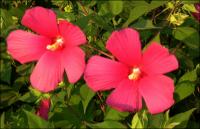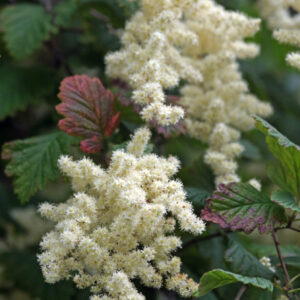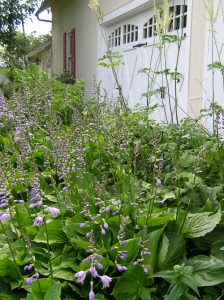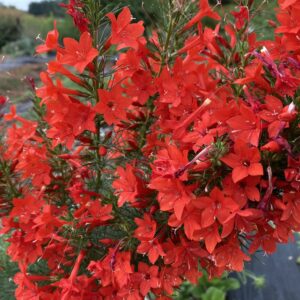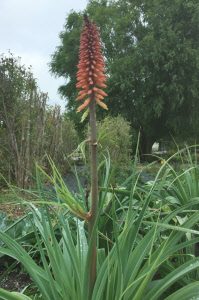Plants for Hummingbirds
Showing 33–40 of 78 results
-
Hibiscus moscheutos Rose mallow Z 5-9
August and September, bodacious, white, pink or crimson platters, looking like the tropics.
August and September, bodacious, white, pink or crimson platters, looking like the tropics.
Size: 5-8' x 3'
Care: Sun, moist to moist well-drained soil, no staking needed.
Native: Southern U.S.
Wildlife Value: Attracts butterflies esp. Cloudless Sulphur butterflies relish Rose mallow’s nectar.One Native American tribe used this plant to cure inflamed bladders. 1st collected by Rev. John Banister (1649-1692) who moved to colonial Virginia in 1678. A gunman mistakenly shot and killed him while he collected plants. Cultivated by Lady Skipworth in her colonial Virginia garden. Bloomed for Jefferson in July, 1767. Grown at America’s 1st botanic garden, Elgin Botanic Garden 1811.
-
Holodiscus discolor Creambush, Ocean spray Z 5-10
Multistemmed shrub with dense, elegant pyramidal clusters of arching cream-colored flowers in early to mid summer. Leaves tint red in fall.
OUT OF STOCK
Multi-stemmed shrub with dense, elegant pyramidal clusters of arching cream-colored flowers in early to mid-summer. Leaves tint red in fall.
Size: 4-8’ x 8’
Care: sun to part shade in moist to moist well-drained soil
Native: Montana to Colorado west to the Pacific.
Wildlife Value: nectar for hummingbirds, food for butterfly caterpillars, bird habitat.Hard and durable wood was used to make digging sticks, spears, harpoon shafts, bows, and arrows by nearly all coastal Native groups. A few used the wood to make sticks to barbeque salmon, fish hooks, needles for weaving and knitting, Pegs were made to use like nails. Others made wood intoarmor plating and canoe paddles.
A few Natives made an infusion of boiled fruit to cure diarrhea, measles, chickenpox and as a blood tonic. Collected by Meriwether Lewis in today’s Idaho on the Clearwater River, May 29, 1806 en route back east on the Lewis and Clark Expedition. -
Hosta ‘Blue Cadet’
Lavender flowers late in season
Lavender flowers late in season
Size: 35-40” x 36”
Care: part to full shade in moist well-drained soil
Awards: Nancy Minks Award in 1986Hosta was named for Dr. Nicholas Host (1761 – 1834) the physician to the emperor of Austria and an expert on grasses. This cultivar ranked as one of the top 7 hostas and one of the top 2 hostas with blue foliage. Hybridized by Aden in 1974.
-
Hosta lancifolia Lanceleaf Hosta Z 3-8
Lavender flowers in late summer to early autumn
Lavender flowers in late summer to early autumn
Size: 18" x 30"
Care: sun to shade in moist well-drained soil.
Native: Japan
Wildlife Value: attracts hummingbirdsJapanese called Hostas Giboshi and ate young leaves in spring as a vegetable. Hosta was named for Dr. Nicholas Host (1761-1834) the physician to the emperor of Austria. Hostas, cultivated since at least the 12th century in Asia, were first described for Europeans by Englebert Kaempfer in 1712, doctor for the Dutch East Indian Company on Dechima Island. . He taught Japanese interpreters astronomy and math and plied them with liquor in exchange for plants. H. lancifolia drawings date to 1690. Cultivated in the U.S. since the late 1800’s.
-
Hosta ventricosa Z 3-8
rich lavender bells periscope over heart-shaped leaves
In late summer rich lavender bells periscope over heart-shaped, prominently veined foliage.
Can not ship to: Maryland
Size: 20" x 36"
Care: Part shade in moist to moist well-drained soil. Tolerate Walnut toxicity
Native: China
Wildlife Value: attracts hummingbirds
Awards: Received England's Royal Horticultural Society Award of Merit.Japanese called Hostas Giboshi and ate young leaves in spring as a vegetable Hosta was named for Dr. Nicholas Host (1761-1834) the physician to the emperor of Austria. Hostas, cultivated since at least the 12th century in East Asia. Empress Josephine grew this at Malmaison. Redoute, Josephine’s botanical illustrator, painted H. ventricosa in 1805.
-
Ipomopsis aggregata Standing cypress, Skyrocket, Scarlet gilia Z 4-11 Reseeding biennial
Many attention-grabbing, cardinal red trumpets on a leafless spike in summer-fall gardens
Many attention-grabbing, cardinal red trumpets on a leafless spike in summer-fall gardens
Size: 3-5’ x 12”
Care: sun to part shade in moist well-drained to well-drained soil
Native: west from ND, south to TX to the Pacific Ocean, also western Canada
Wildlife Value: attracts bees, Swallowtail butterflies and flocks of hummingbirds. Deer resistant.Hopi made it into decorations and dye. Klamath children sucked its nectar from the flowers. Navajo remedied many ailments with this – spider bites. stomach ailments by induce purging. And they grew it for its beauty. Canada’s Salish washed their face, hair, and eyes with this. Shoshone remedied pains of rheumatism by crushing the plants and applying it to the aches. Also a remedy sexually transmitted diseases, itches, tonic for blood and induce vomiting,
Collected by Meriwether Lewis on the Lolo Trail crossing the Bitterroot Range of the Rockies, June 26 1806. Named and described initially by Frederick Pursh in Flora Americae Septronalis Vol1 p. 147 (1813) from the plant collected by Lewis on the Lewis and Clark Expedition. -
Iris missouriensis Western blue flag, Rocky Mountain iris Z 3-8
In spring variegated, violet blue iris flowers - 6 perianth segments, 3 spreading to reflexed falls with a dark yellow-orange stripe down the middle with blue lines on a white background, & 3 purple standards.
In spring variegated, violet blue iris flowers – 6 perianth segments, 3 spreading to reflexed falls with a dark yellow-orange stripe down the middle with blue lines on a white background, & 3 purple standards.
Size: 12-24” x 9-12”
Care: sun to part shade in moist well-drained to moist soil. Divide regularly.
Native: Alberta and British Columbia, from Minnesota to Washington south to California east to New Mexico
Wildlife Value: Deer resistant. Attracts hummingbirds, provides pollen to bees.Named for the Missouri River although ironically Lewis collected it along the Blackfoot River in today’s Montana on July 5, 1806.
Paiute Indians of eastern California and southeastern Oregon made ear drops to remedy earaches with a decoction if the Iris roots. -
Kniphofia caulescens Red hot poker, Regal torch lily Z 5-10
fat spikes of flowers open coral-red, turning pale lemon-yellow
Evergreen perennial with short, stout stems bearing grass-like broad, grey-green leaves. Blooming July to August, fat spikes of flowers open coral-red, turning pale lemon-yellow
Size: 3’ x 2-3’
Care: sun in moist well-drained soil
Native: Lesotho South Africa
Wildlife Value: deer and rabbit resistant. Attracts hummingbirds
Awards: Royal Horticultural Society Award of Garden Merit; Denver Botanic Garden Plant SelectIntroduced to gardens by Mr. T. Cooper about 1860. 1st described by French botanist Carrière in Revue Horticole in 1884

